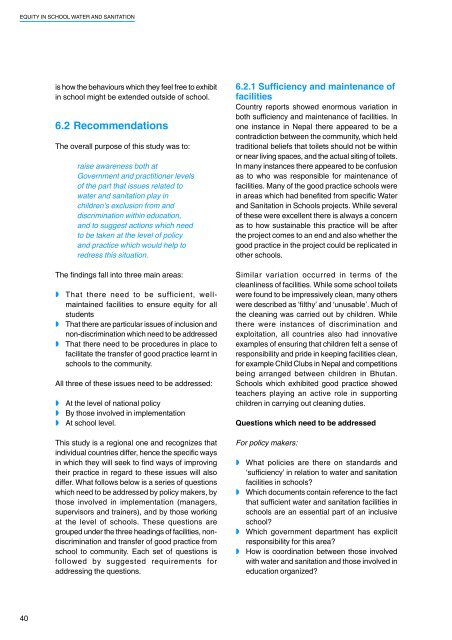Equity in School Water and Sanitation
Equity in School Water and Sanitation
Equity in School Water and Sanitation
Create successful ePaper yourself
Turn your PDF publications into a flip-book with our unique Google optimized e-Paper software.
EQUITY IN SCHOOL WATER AND SANITATIONis how the behaviours which they feel free to exhibit<strong>in</strong> school might be extended outside of school.6.2 RecommendationsThe overall purpose of this study was to:raise awareness both atGovernment <strong>and</strong> practitioner levelsof the part that issues related towater <strong>and</strong> sanitation play <strong>in</strong>children’s exclusion from <strong>and</strong>discrim<strong>in</strong>ation with<strong>in</strong> education,<strong>and</strong> to suggest actions which needto be taken at the level of policy<strong>and</strong> practice which would help toredress this situation.The f<strong>in</strong>d<strong>in</strong>gs fall <strong>in</strong>to three ma<strong>in</strong> areas:That there need to be sufficient, wellma<strong>in</strong>ta<strong>in</strong>edfacilities to ensure equity for allstudentsThat there are particular issues of <strong>in</strong>clusion <strong>and</strong>non-discrim<strong>in</strong>ation which need to be addressedThat there need to be procedures <strong>in</strong> place tofacilitate the transfer of good practice learnt <strong>in</strong>schools to the community.All three of these issues need to be addressed:At the level of national policyBy those <strong>in</strong>volved <strong>in</strong> implementationAt school level.This study is a regional one <strong>and</strong> recognizes that<strong>in</strong>dividual countries differ, hence the specific ways<strong>in</strong> which they will seek to f<strong>in</strong>d ways of improv<strong>in</strong>gtheir practice <strong>in</strong> regard to these issues will alsodiffer. What follows below is a series of questionswhich need to be addressed by policy makers, bythose <strong>in</strong>volved <strong>in</strong> implementation (managers,supervisors <strong>and</strong> tra<strong>in</strong>ers), <strong>and</strong> by those work<strong>in</strong>gat the level of schools. These questions aregrouped under the three head<strong>in</strong>gs of facilities, nondiscrim<strong>in</strong>ation<strong>and</strong> transfer of good practice fromschool to community. Each set of questions isfollowed by suggested requirements foraddress<strong>in</strong>g the questions.6.2.1 Sufficiency <strong>and</strong> ma<strong>in</strong>tenance offacilitiesCountry reports showed enormous variation <strong>in</strong>both sufficiency <strong>and</strong> ma<strong>in</strong>tenance of facilities. Inone <strong>in</strong>stance <strong>in</strong> Nepal there appeared to be acontradiction between the community, which heldtraditional beliefs that toilets should not be with<strong>in</strong>or near liv<strong>in</strong>g spaces, <strong>and</strong> the actual sit<strong>in</strong>g of toilets.In many <strong>in</strong>stances there appeared to be confusionas to who was responsible for ma<strong>in</strong>tenance offacilities. Many of the good practice schools were<strong>in</strong> areas which had benefited from specific <strong>Water</strong><strong>and</strong> <strong>Sanitation</strong> <strong>in</strong> <strong>School</strong>s projects. While severalof these were excellent there is always a concernas to how susta<strong>in</strong>able this practice will be afterthe project comes to an end <strong>and</strong> also whether thegood practice <strong>in</strong> the project could be replicated <strong>in</strong>other schools.Similar variation occurred <strong>in</strong> terms of thecleanl<strong>in</strong>ess of facilities. While some school toiletswere found to be impressively clean, many otherswere described as ‘filthy’ <strong>and</strong> ‘unusable’. Much ofthe clean<strong>in</strong>g was carried out by children. Whilethere were <strong>in</strong>stances of discrim<strong>in</strong>ation <strong>and</strong>exploitation, all countries also had <strong>in</strong>novativeexamples of ensur<strong>in</strong>g that children felt a sense ofresponsibility <strong>and</strong> pride <strong>in</strong> keep<strong>in</strong>g facilities clean,for example Child Clubs <strong>in</strong> Nepal <strong>and</strong> competitionsbe<strong>in</strong>g arranged between children <strong>in</strong> Bhutan.<strong>School</strong>s which exhibited good practice showedteachers play<strong>in</strong>g an active role <strong>in</strong> support<strong>in</strong>gchildren <strong>in</strong> carry<strong>in</strong>g out clean<strong>in</strong>g duties.Questions which need to be addressedFor policy makers:What policies are there on st<strong>and</strong>ards <strong>and</strong>‘sufficiency’ <strong>in</strong> relation to water <strong>and</strong> sanitationfacilities <strong>in</strong> schools?Which documents conta<strong>in</strong> reference to the factthat sufficient water <strong>and</strong> sanitation facilities <strong>in</strong>schools are an essential part of an <strong>in</strong>clusiveschool?Which government department has explicitresponsibility for this area?How is coord<strong>in</strong>ation between those <strong>in</strong>volvedwith water <strong>and</strong> sanitation <strong>and</strong> those <strong>in</strong>volved <strong>in</strong>education organized?40












